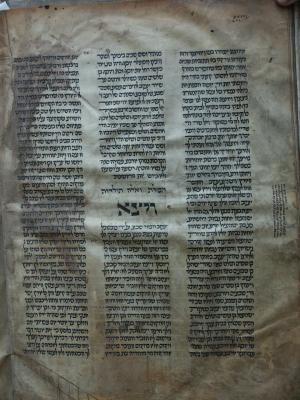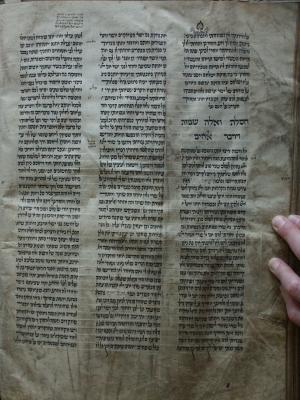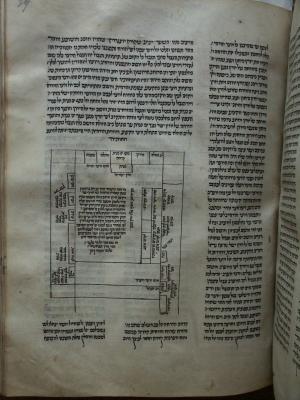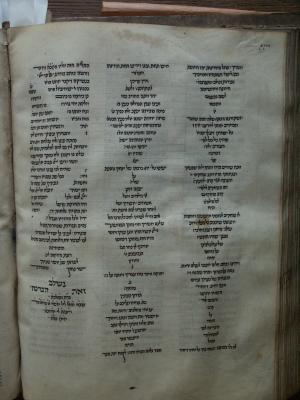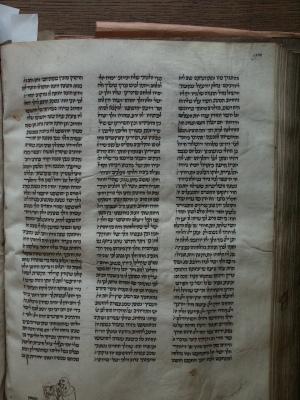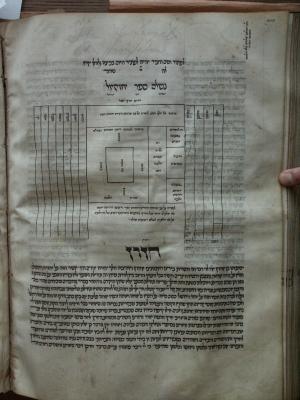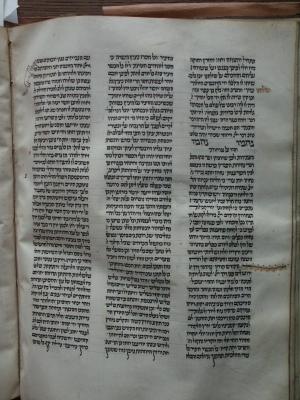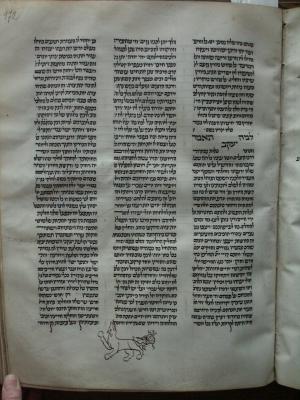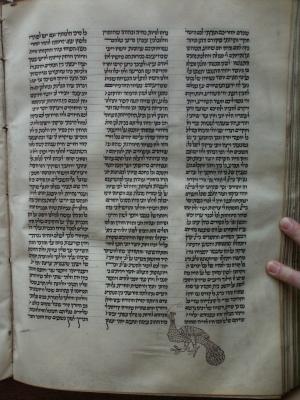Obj. ID: 23160
Hebrew Illuminated Manuscripts Vienna Rashi Commentary, South Germany, 13th-14th century

The Vienna Rashi Commentary on the Bible was copied most probably between the second half of the 13th century to the first half of the 14th century, in Southern Germany, most probably in the region ofFranconia. The manuscript was copied by two alternating scribe-artists named Menahem and Avraham. The scribes wrote on separate quires, and it would seem that they did not divide the quires between them and work simultaneously, but rather worked one after the other. This may be evident in two places where the last few words of quires written by scribe A were repeated also in the following quire written by scribe B (e.g., fols. 108v-109), most probably as a method of conserving the order of the quires. Each scribe was apparently responsible for the ruling of his own quire, scribe A using a gray plummet and scribe B using a brown plummet and stylus (e.g., fols. 63-75v). Each scribe also added decoration to the sections written by him.
Rashi’s commentary on the Bible was copied down into many manuscripts produced in the Middle Ages, most commonly appearing in the margins surrounding the text of the Bible (as can be seen for example in Cod. Hebr. 28 of the ÖNB collection) Manuscripts dedicated solely to the text of Rashi’s commentary, without including the biblical text – as is the case in this Viennamanuscript - are not as common. Many of the surviving examples are incomplete and contain only commentary to several books. The Viennamanuscript is an almost complete example, missing only the book of Chronicles. Our Vienna Rashi Commentary on the Bible served as the Hebrew text edition for the translation of Rashi's commentary on Psalms into English by (Gruber, Rashi's Commentary, pp. 811-860).
Several of these other examples of Rashi's commentary on the Bible of Ashkenazi origin are set in a similar format to our manuscript, displaying the text in three columns with headings for the different books and/or pericopes (e.g., ÖNB Cod. Hebr. 3, dating to the 13th-14th century; Berlin, Or. Fol. 1221, dating to the 13th century; Leiden, Bibliotheek der Rijksuniversiteit Cod. Or. 4718 dated 1270). Most of the surviving manuscripts containing the text of Rashi’s commentary on the Bible as a separate unit are undecorated or include only slight decorations, such as wriggly work surrounding the initial words or shaped text (e.g., Berlin, Staatsbibliothek Or. Fol. 1221 dating to the 13th century; Biblioteca Ambrosiana C119 INF, dating to the 13th century; Leiden, Bibliotheek der Rijksuniversiteit Cod. Or. 4718, dated 1270). A rare example of a richly decorated manuscript which includes, among other commentaries, the text of Rashi's commentary on the Bible as well, in a similar (though not identical) format to the Vienna manuscript, is one of the earliest surviving example of an illuminated Ashkenazi manuscript, known as The Rashi of Warzburg, written by Shlomo ben Shmuel of Warzburg in 1233 (Mϋnchen, Bayerische Staatsbibliothek, Cod. Hebr. 5, Vols. I & II).
The decoration of our Vienna Rashi Commentary on the Bible includes one text illustration, four maps illustrating the text, decorated initial words, decoration indicating the names of the scribes, decorated catchwords, and shaped text.
The text illustration depicts a crude penwork drawing of Jacob's ladder (fol. 12v) as an illustration to the biblical text and Rashi's commentary on the section of Genesis 28:12-15 describing Jacob's dream of a ladder, on which are angels of G-d ascending and descending. Text illustrations of Jacob's ladder appear in other manuscripts as well, but are often composed of micrography rather than just an outline as seen in our manuscript (e.g. Cod. Hebr. 28 of the Viennacollection mentioned above, fol. 39v and Vat. Ebr. 14, fol. 31). In both of these examples, as in our manuscript, the ladder is depicted simply in schematic lines, tilted diagonally to the left and there is no depiction of other elements mentioned in the biblical text.
The Vienna Rashi Commentary on the Bible contains four maps, illustrating the adjacent text and executed in ink by the scribes responsible for the copying of the text of the folio where they appear - three of them by scribe A (Menahem) and one by scribe B (Avraham). These four maps appear as well in a group of Ashkenazi copies of Rashi's commentary on the Bible as a separate text, dating between the 13th and the 14th century and all written in semi-cursive Ashkenazi script. The maps appearing in this group were most probably executed by the scribes, usually in an unsophisticated, schematic manner as in our manuscript, though some are more exact and detailed (two examples of manuscripts of this group which are not decorated are housed in the Vienna collection – ONB 23, 24). Other examples are the maps found in the Rashi of Warzburg (Mϋnchen, Bayerische Staatsbibliothek, Cod. Hebr. 5, Vols. I & II), described in detail by Professor Narkiss (Narkiss, Rashi U'mapotav, pp. 435-439) and the maps found in four manuscripts housed in Paris, Bibliotheque Nationale Cod. Hebrèus 154, 155, 161, 156, described in detail by Gabriella Sed-Rajna (Sed-Rajna, Les Manuscrits Hebreux, pp. 224-232). In several of the other examples from this group, appears an additional map illustrating the text of Numbers 34: 2-12 which does not appear in our manuscript (see for example Rashi of Warzburg, Vol. I, fol. 139). The map illustrating Judges 21:19, appearing in our manuscript is only sometimes included in other manuscripts in this group (see for example ÖNB Cod. Hebr. 3, fol. 147 andOxford, Bodleian Library, Ms. Opp. 34, fol. 125). The maps depicted in this group of manuscripts are similar in all the copies, except for minor variants.
Special attention has been given by researchers to these maps included in manuscripts containing the text of Rashi's commentary, in an attempt to determine whether these maps are copies of ones drawn by Rashi himself in his original text, now lost to us. Two textual evidences support this assumption. The first is to be found in the commentary of the Rashbam (Rashi's grandson) to Numbers 34:2 reading "Although our Rabbi, my grandfather, has already explained it and has drawn pictures of the boundaries, let us explain it" (רבינ זקיני פירש וצייר תחומין ואף על פי כן אפרש בקוצר). The second evidence for the authenticity of the diagrams is found in Berlin, Staatsbibliothek, Or. Fol. 122, dating to the 13th century, which includes Rashi's commentary on the Prophets and Hagiographia. On fols. 72-72v, the map illustrating Ezekiel 45:1-7 is followed by Rashi's letter to the rabbis of Auxerre (רבני אלצורא). In this letter, Rashi answers a question addressed to him regarding the location of the outer chambers of the Temple, adding at the end of his answer "I cannot add [anything] to the commentary I have given in the quires but I will draw their figure and shall send them the drawings" (איני יודע מה להוסיף על מה שפי' בקונטרסים אך צורתם אצור ואשלח לך). It is important to note that these maps found in Hebrew medieval manuscripts were later omitted from the printed editions of Rashi's commentary.
One interesting variant in the Vienna Rashi Commentary on the Bible is to be found in the map on fol. 79, in the paragraph written in the centre of the map, relating to the Mountain of Hor. This paragraph is found in other manuscripts of this group and was identified as being similar - though not identical - to Rashi's commentary on Gittin 8a. The ending words of the paragraph in most of the other manuscripts are "a mountain above a mountain like an apple" ( הר על גבי הר כמין תפוח), which is the way the words appear in Gittin. In our manuscript the paragraph ends with the words "mountain on top of a mountain like a large apple above a small apple" ( (הר על גבי הר כמין תפוח גדול על גבי (תפוח קטן. This is a reversal of a phrase found in Rashi's commentary on Numbers 20: 22, and in other sources as well, describing the Mountain of Hor as a "mountain on top of a mountain, like a small apple above a large apple" (הר על גבי הר כתפוח קטן על גבי תפוח גדול).
Manuscripts including Rashi's commentary on Prophets and Hagiographa are fewer in number than those including only Rashi's commentary to the Pentateuch, and as such the two maps illustrating texts of Ezekiel appear less often in manuscripts of this group. The maps drawn in ourViennacommentary are similar in content to those appearing for example in Paris, Bibliotheque Nationale, Hebreu 154, Vat. Ebr. 94,Berlin,Berlin, Staatsbibliothek, Or. Fol. 1221, Vienna ÖNB ms. 23, 24 and Paris, Bibliotheque Nationale, Hebreu 161.
An interesting variant found in this map on fol. 152v of ourViennamanuscript is the fact that the portion of the tribe of Gad, which in other copies of this map appears on the far right section after the tribe of Zevulun, is missing from our map. On the top margin of the page is a scribal note written vertically and marked above with cross-hatch (#) The note reads: “And I the scribe am surprised that I did not find the tribe of Gad illustrated” (ואני הכותב תמהתי שלא מצאתי/שבט גד מצוייר). It would seem that the scribe is expressing his surprise over the fact that he did not find the tribe of Gad in the map of the model from which he was copying. He did not correct this omission found in the model but felt obligated to state that it was not his own oversight, rather that of someone else.
One of the main elements of the decoration of the Vienna Rashi Commentary on the Bible is that each of the scribes indicated his name by decorating it whenever it appeared in the text. Scribe A - Menahem – marked his name 18 times with dotted flourishes and scribe B – Avraham – marked his name 14 times in different ways – mostly with pen drawings of quadrupeds, birds, and a hybrid and also by dots extending into the margin (see Decoration program, Category D). Although the marking of names is a common practice employed by Ashkenzi scribes, our manuscript shows a rare example of scribes who choose to employ this device many times in one manuscript.
Scribe B was also responsible for the decorated catchwords executed in ink, appearing at the end of many quires written by him. The style of the decorations and the technique of pen-work employed by this scribe-artist can be compared to those appearing in a group of manuscripts originating in Southern Germany, most probably in the region of Franconia, dating between the end of the 13th century to the first half of the 14th century. Many of these
sub-set tree:
| Cod. Hebr. 12b (Previously 220, Schwartz, No. 23)
Parchment, I+276+I leaves
Measurements
|
Full page: (420-425) x (315-318)mm |
|
Main text: (310-313) x (235-240)mm |
|
Column width: (65-68)mm |
Scribes
Two scribes
|
Scribe A: Menahem |
Main text and commentary text |
Fols. 1v-22v, 95-108v, 149-152v, 182-276 |
|
Scribe B: Avraham |
Main text |
Fols. 23-94v, 109-148v, 153-181v |
Script
|
Main text of scribes A and B written in semi-cursive Ashkenazi script in light brown and brown ink. Commentary texts in the margins of sections of scribe A, written by scribe A in shaped text in small semi-cursive Ashkenazi script in dark brown ink. |
|
Some captions for sections written in square Ashkenazi script in dark brown ink by scribe B (e.g., fols. 24v, 50v, 63, 93, 127v, 131v). |
Number of columns
|
Mostly in three columns. |
|
Number of lines
|
Main text: |
41-42 lines per page, mostly in three columns (except for: fols. 20v, 21, 108, 152v) |
|
Commentary: |
Shaped text in varying number of lines (e.g., fols. 6v, 7, 8, 8v, 9,17v, 103v, 107v, 149) |
Ruling
Ruling by plummet is discernable on most folios both on the recto and the verso (e.g., fols. 9, 11, 43, 81, 87v, 106v, 107, 131, 165v, 175, 206, 236v, 242, 262, 270v, 276). Ruling for scribe A is in gray plummet and for scribe B in brown plummet. Scribe B also has some ruling in stylus (e.g., fols. 63-75v). 42-43 horizontal lines. 5-6 lines of which are ruled across the entire width of the page (lines 1, 2, 22 and/or 24, 40, 42). Mostly 1+2+2+1 vertical lines, but also 2+2+2+1 vertical lines by scribe A (fols. 182-276).
Pricking
Pricking is discernable in the inner (except for fols. 274, 275), outer (e.g., fols. 78, 111, 148, 155-165, 179-181), lower (e.g., 120, 122, 200-203) and upper (e.g., fols. 156, 200, 202, 214-218) margins.
Quires
38 quires of mostly 8 leaves each except for I4, III10, XIV6, XV6-3 (3 last leaves cut out, no text missing), XX8-3 (3 last leaves cut out, no text missing), XXI4, XXII8-1(first leaf cut out, no text missing), XXIII6, XXVI6, XXXVII6, XXXVIII6-3 (3 last leaves cut out).
Catchwords
Catchwords for the quires appear in the lower left corner of many of the last versos of quires, mostly in sections written by scribe B (e.g., fols. 30v, 38v, 46v, 111v, 119v, 135v, 159v, 165v, 173v, 181v) and sometimes in sections written by scribe A (e.g., fols. 219v, 235v, 251v, 259v, 273v). Some of the catchwords written by scribe B are decorated (e.g., fols. 30v, 119v, 181v).
Hebrew numeration
None
Blank leaves
Fols. 1 and 276v were originally blank and now contain later inscriptions.
The decoration was made in 1 stage by both of the scribes responsible for the copying of the text.
A. One text illustration of a ladder (fol. 12v) set in the lower margin, below the text of commentary on Jacob's dream (Genesis 28: 12-15)
B. Four maps illustrating the text, executed in ink by the scribe who wrote the corresponding text (scribe A: fols. 103, 150, 152v and scribe B: fol. 79), and drawn according to the biblical text and Rashi's commentary. The first map (fol. 79 ) illustrates the boundaries of theLand ofIsrael (Numbers 34:2-12). The second (fol. 103) illustrates the location of the city ofShiloh (Judges 21:19). The third (fol. 150) map illustrates the city of Jerusalem in the days of the Third Temple (Ezekiel 45:1-7) and the fourth (fol. 152v) illustrates the reapportionment of the Land of Israel among the Twelve Tribes of Israel in the days of the Third Temple (Ezekiel 48: 1-27).
C. Three decorated initial words for the opening of books written by scribe B, in dark brown ink. Two of the initial words are surrounded by wriggly work (fols. 48v, 63), one of them incorporated with four dogs (fol. 63) and the third initial word has circles set on the junctions of the letters (fol. 134v).
D. Decoration indicating the names of the scribes. Scribe B (Avraham) indicates his name many times when appearing in the text, with pen drawings of several motifs: quadrupeds (e.g., fols. 25v, 80v, 118v, 171v, 172) or winged birds of different kinds, (e.g, fols. 74v, 161, 174v, 175) set in the margins adjacent to the name. The birds and quadrupeds sometime pick at the name with their beak or mouth (e.g., fols. 161, 172, 174v). The scribe's name is also decorated once by a hybrid holding a cup, set in the margin next to the name (fol. 30), once by a crown (fol. 26v), once by foliate leaves (fol. 81v) and once by dots set above the name (fol. 138v). One of these may possibly also serve as a text illustration, alluding to the animal mentioned in the text next to which it is depicted (e.g., fols. 25v).
Scribe A (Menahem) also indicates his name many times when it appears in the text, by decorating it above with dots forming a small flourish (e.g., fols. 96v, 186, 198, 198v, 200, 201v, 202, 202v, 207, 211, 214, 239v, 244v) . Twice he decorates the letters of his name with dots when they appear in different words, thus forming an acrostic (fols. 207, 248).
E. Decorated catchwords executed by scribe B, set in the lower left-hand corner of many of the last versos of quires (e.g., fols. 30v, 80v, 119v, 181v). The catchwords are decorated by pen drawings of animals and birds such as: a horse (fol. 30v), a bird catching a fish in its mouth (fol. 80v), a monkey riding a lion while playing a musical instrument (fol. 119v), an effaced drawing of a man eating a fish (fol. 176 and a large bird (fol. 181v). One of these may possibly also serve as a text illustration alluding to the animal mentioned in the text below which it is depicted (fol. 30v).
F. Shaped main text by scribe B forming triangles and diamonds (fol. 94v, 276).
G. Many shaped commentary text, by assorted commentators written by scribe A (for example "R. Samuel" ( ר' שמואל ) (fol.9v, 17v), "R. Sampson", (ר' שמשון ) (fol. 18), "R. Samuel son of Isaac", (ר' שמואל בר יצחק ) (fol. 18v), "DaKh" ד"ך (fol. 23v). The commentary text is set in the margins and was written by scribe A in different shapes: circles (e.g., fols. 6v, 7, 8, 8v, 9, 9v, 11, 11v, 12, 13, 14v, 15, 17v, 20, 21, 22, 103, 159v, 151) and triangles (e.g, fols. 4, 4v, 16, 149). Sometimes these are set one on top of the other forming the shape of a vase (e.g., fols. 4v, 5). Sometimes the commentary text is set on the curve of a corner (e.g., fols. 2, 2v, 4, 6, 9, 17v, 103, 107v).
H. Several small decorated Haftarah signs set in the margins, executed by scribe A in brown ink. The signs are comprised of a simple diamond-shaped frame surrounding the name of the Haftarah (e.g., 101v, 107v).
[


